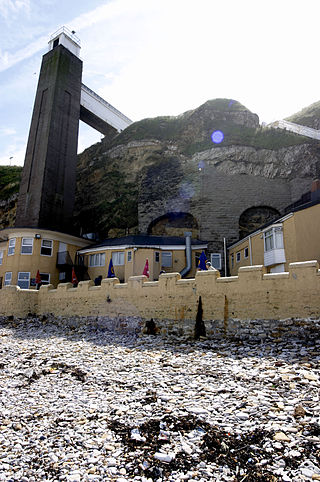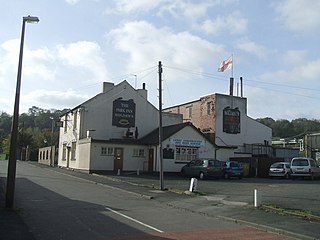
A pub is in several countries a drinking establishment licensed to serve alcoholic drinks for consumption on the premises. The term first appeared in England in the late 17th century, to differentiate private houses from those open to the public as alehouses, taverns and inns. Today, there is no strict definition, but the Campaign for Real Ale (CAMRA) states a pub has four characteristics:
- is open to the public without membership or residency
- serves draught beer or cider without requiring food be consumed
- has at least one indoor area not laid out for meals
- allows drinks to be bought at a bar

Nottingham is a city and unitary authority area in Nottinghamshire, East Midlands, England. It is located 33 miles (53 km) south-east of Sheffield and 45 miles (72 km) north-east of Birmingham. Nottingham is the legendary home of Robin Hood and to the lace-making, bicycle and tobacco industries. The city is also the county town of Nottinghamshire and the settlement was granted its city charter in 1897, as part of Queen Victoria's Diamond Jubilee celebrations.

Greene King is a British pub and brewing company founded in 1799, currently based in Bury St Edmunds, Suffolk. The company also owns brands including Hungry Horse and Farmhouse Inns, as well as other pubs, restaurants and hotels. It was listed on the London Stock Exchange (LSE), until it was acquired by CK Assets in October 2019.

Pub names are used to identify and differentiate traditional drinking establishments. Many pubs are centuries old, and were named at a time when most of their customers were illiterate, but could recognise pub signs. The use of signage was not confined to drinking establishments. British pubs may be named after and depict anything from everyday objects, to sovereigns, aristocrats and landowners. Other names come from historic events, livery companies, occupations, sports, and craftsmen's guilds. One of the most common pub names is the Red Lion. This list contains both modern and historical examples.

The Marsden Grotto, locally known as The Grotto, is a gastropub located on the coast at Marsden in South Shields, Tyne & Wear, England. It is partly dug into the cliff face and fronted with a more conventional building opening onto the beach. The pub is one of the very few "cave bars" in Europe, another being Ye Olde Trip to Jerusalem in Nottingham.

Ye Olde Fighting Cocks is a pub in St Albans, Hertfordshire, England. It is one of several pubs that lay claim to being the oldest in England, claiming to have been in business since 793 AD. Its claim to that date is somewhat uncertain: the building is described by Historic England as being of 16th-century appearance, and the earliest date for which it might have been licensed is 1756. Other pubs such as Ye Olde Man & Scythe in Bolton, Greater Manchester, and Ye Olde Trip to Jerusalem in Nottingham also make unproved claims to being the oldest. Ye Olde Fighting Cocks was once listed as the oldest in England by the Guinness World Records, but the record was withdrawn from consideration in 2000 because it was deemed impossible to verify.

Ring a bull is a pub game. A bull's nose-ring on a length of string is swung in an arc with the aim of hooking onto a bull's horn or hook attached to the wall. The ring must stay on the hook to count as a successful throw.
Holywell is a village in Cambridgeshire, England, approximately 6 miles (10 km) east of Huntingdon, in the civil parish of Holywell-cum-Needingworth. It is situated within Huntingdonshire, a non-metropolitan district of Cambridgeshire, and is a historic county of England.

Holden's Brewery is a family-run English regional brewery. It was founded in 1915 at the Park Inn in Woodsetton, Dudley, in the West Midlands.

Ye Olde Man & Scythe is a public house on Churchgate in Bolton, England. The earliest recorded mention of its name is in a charter from 1251, making it one of the ten oldest public houses in Britain and the oldest in Bolton. The present form of the name, prefixed with "Ye Olde", is a pseudoarchaism derived from the Man and Scythe Inn; it derives from the crest of the Pilkington family, which consists of a reaper using a scythe, alluding to a tradition about one of the early members of the family.

Nottingham is a city in Nottinghamshire, England.

The Bell Inn is a pub in Nottingham, England. Completed from around 1437, it claims, along with Ye Olde Trip to Jerusalem and Ye Olde Salutation Inn, to be the oldest pub in the city. In 1982 the pub became a Grade II listed building.

Ye Olde Salutation Inn is a Grade II listed public house, with parts dating from around 1240, which lays claim to being the oldest pub in Nottingham. The inn also has a claim to being the most haunted pub in the country, one landlord having asserted the presence of 89 resident apparitions. Aside from these claims, it is best known locally for its rock music and has been described by local historian Dave Mooney as "an old fashioned rock and bike pub."
Nottingham Brewery, is a microbrewery located in Nottingham, England. The name Nottingham Brewery refers to two different breweries in the Nottingham area. The first was established in 1847 and situated on Mansfield Road, next door to The Rose of England public house. The Brewery was demolished to make for York House, which itself was demolished in 2016. The current brewery was established in 2001 in Radford.
The Nottingham Caves Survey was a research project the aim of which was to scan every accessible cave from the 700+ man-made sandstone caves that are known to be present in the city of Nottingham. It was conducted by Trent and Peak Archaeology, at the University of Nottingham. It was managed by Dr David Strange-Walker with Julia Clarke, with documentary research undertaken by Scott Lomax. The project was funded primarily by both the Greater Nottingham Partnership, who have an interest in utilising the caves for increasing tourism and helping grow the local economy, and English Heritage, who are motivated by an interest in preserving the remaining heritage of Nottingham.
The following is a timeline of the history of the city of Nottingham, England.

Ye Olde Dolphin Inne is a Grade II listed pub, on Queen Street, in the city of Derby, England.

The Mitre Inn is a public house at 58 High Street, Chipping Barnet, London. It was established by 1633 and is probably the oldest remaining of the town's once numerous coaching inns. It is a grade II listed building with Historic England and is currently styled "Ye Olde Mitre Inne".

Ye Olde Rovers Return was a public house in the Withy Grove area of Manchester, England, constructed in the early-14th century. Demolished in 1958, it was the inspiration for the fictional Rovers Return Inn featured in the long-running British soap opera Coronation Street, first broadcast in 1960.


















